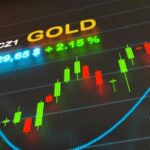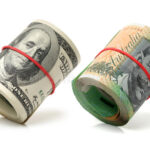Gold price has regained some momentum Despite geopolitical uncertainties and weak USD demand.
The gold price (XAUUSD) trades with a slight positive bias throughout the Asian session on Friday. But lacks follow through and remains below a nearly two-week high reached the previous day.
The Fed’s hawkish stance remains supportive of high US bond yields but limiting increases.
The minutes of the late January FOMC meeting, together with recent comments by senior Federal Reserve (Fed) officials. Indicated that the central bank is not in a hurry to lower interest rates. This continues supportive of the rising US Treasury bonds. Yields, combined with an extension of the risk on surge across global equities markets, prove to be significant headwinds for the non-yielding yellow metal.
The disadvantage for the safe-haven. However, the gold price has remained stable despite the danger of further escalation of geopolitical tensions in the Middle East. Furthermore, despite the Fed’s hawkish view, the US Dollar (USD) has struggled to gain any traction. And in the absence of any relevant market moving economic releases, the commodity may receive additional support. Nonetheless, the XAUUSD appears ready to post modest gains for the first time in three weeks. Albeit the aforementioned fundamental background calls for prudence before putting aggressive bullish bets.
Daily Market Movers: The price of gold is supported by a number of factors, but lacks follow through.
Israel increased its bombardment of Gaza’s Rafah. While Yemen’s Iran-aligned Houthis rebels increased attacks on ships in the Red Sea. Raising the risk of a larger Middle East conflict and supporting the safe haven gold price.
The US Dollar fails to benefit on the previous day’s strong rebound from its lowest level in nearly three weeks. Providing more support for the XAUUSD, though the Federal Reserve’s hawkish outlook may limit gains.
The minutes of the most recent FOMC policy meeting, released on Wednesday. Revealed widespread confusion about how long borrowing costs should continue at their current level in order to bring inflation back down to the central bank’s 2% target.
Fed Vice Chair Philip Jefferson believes the central bank will begin to decrease interest rates later this year.
Fed Vice Chair Philip Jefferson believes the central bank will begin to decrease interest rates later this year. But he will consider a wide range of economic data before concluding. That it is time to drop borrowing costs.
Meanwhile, Philadelphia Fed President Patrick Harker stated. That the central bank is close to decreasing interest rates, but that a move in the near term is unlikely. Emphasizing that he does not want to drop too soon and re ignite inflation.
Separately, Fed Governor Lisa Cook stated that it is not yet appropriate to lower interest rates because the route to the 2% inflation target has been and may continue to be bumpy and uneven. Noting recent higher consumer inflation statistics.
Moreover, Fed Governor Christopher Waller stated that Policymakers should postpone rate decreases for at least a few months to evaluate if the strong inflation reading in January was just a speed bump on the path to price stability.
According to the CME Group’s FedWatch Tool, the markets are pricing in approximately a 30% possibility that the Fed will begin decreasing interest rates in May, while the odds for a move at the June FOMC policy meeting are currently around 66%.
According to data released on Thursday, the number of Americans claiming for unemployment insurance benefits declined from 213,000 to 201,000 during the week ending February 17, indicating new signals of job market resilience.
The yield on the benchmark 10-year US government bonds remains around its highest level. Since late November, it has served as a tailwind for the Greenback, capping the non-yielding yellow metal amid the widespread risk-on mentality.
The better-than-expected release of the flash Eurozone PMI data revealed that the decline in business activity abated in February, boosting investor mood and helping to keep the XAUUSD under control.









